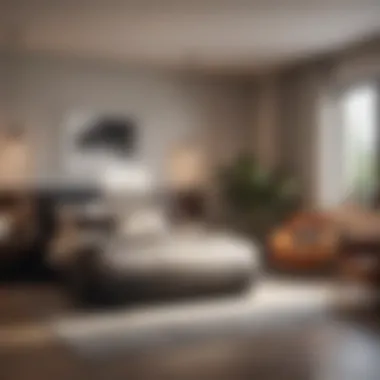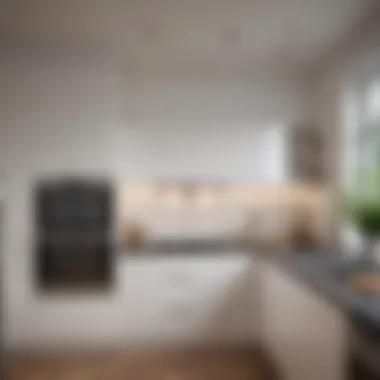Unveiling the Intricacies of One-Bedroom Apartment Dimensions


Interior Design Trends
Introduction
A one-bedroom apartment is not merely a living space; it is a compact yet versatile unit that offers a unique lifestyle experience. In this article, we will delve into the dimensions of one-bedroom apartments, exploring their spatial considerations, layout specifics, and design elements. Understanding the intricacies of these apartments is crucial for individuals seeking to maximize functionality and aesthetics within a limited space.
Defining a One-Bedroom Apartment
When we talk about a one-bedroom apartment, we refer to a residential unit that comprises a single bedroom alongside a living area, kitchen, and bathroom. These apartments are designed to cater to the needs of individuals or couples looking for a functional yet cozy living space. The defining feature of a one-bedroom apartment is its ability to provide essential living areas within a compact floor plan, making efficient use of available space.
Purpose of the Article
The primary objective of this article is to provide readers with a comprehensive guide to one-bedroom apartments, shedding light on their varying dimensions and configurations. By examining the size variations, room layouts, and practical tips for living in such spaces, readers will gain valuable insights into optimizing their one-bedroom living experience. Whether you are a real estate enthusiast, a travel lover intrigued by compact living, or an interior design aficionado seeking creative inspiration, this article aims to offer you a nuanced understanding of one-bedroom apartments and empower you to make informed decisions regarding these unique living spaces.
Standard Dimensions
In the realm of one-bedroom apartments, understanding standard dimensions is crucial. These dimensions are not arbitrary but rather meticulously planned to optimize space utilization. By adhering to industry-standard measurements, builders and designers ensure that each square footage is maximized to create functional and aesthetically pleasing living spaces. Embracing standard dimensions allows for consistency in room sizes and layouts, offering inhabitants a sense of familiarity and ease in navigation within the apartment. Considerations such as average square footage, room sizes, and door widths play a significant role in determining the comfort and usability of one-bedroom apartments.
Average Square Footage
The average square footage of a one-bedroom apartment varies based on location, building type, and architectural design. Generally, these apartments range from 500 to 900 square feet, providing ample living space for individuals or couples. In urban settings, where space comes at a premium, compact one-bedroom apartments around 500 square feet are common. On the other hand, suburban or luxury apartments may offer larger floor plans up to 900 square feet, allowing for more spacious living areas and additional amenities. Understanding the average square footage helps prospective residents assess their lifestyle needs and choose an apartment that aligns with their preferences.
Room Sizes
Bedroom
The bedroom in a one-bedroom apartment serves as a sanctuary for rest and relaxation. Typically, the bedroom size ranges from 100 to 200 square feet, accommodating a standard double or queen-sized bed along with essential furniture like dressers and nightstands. Optimal bedroom sizes ensure ample space for movement and storage while creating a cozy atmosphere for unwinding after a long day. The layout and orientation of the bedroom are pivotal in maximizing functionality and comfort, with considerations for natural light ingress and privacy.


Living Room
The living room acts as the central gathering space for socializing and entertainment. With dimensions averaging between 150 to 300 square feet, the living room offers versatility in furniture arrangement and activity zones. From hosting guests to relaxing with a book, the living room layout greatly impacts the apartment's overall ambiance. Strategic placement of seating areas, multimedia consoles, and decorative elements enhances the functionality and visual appeal of the living room, contributing to a vibrant and inviting atmosphere.
Kitchen
A well-designed kitchen maximizes efficiency and convenience within a one-bedroom apartment. Typically ranging from 50 to 150 square feet, the kitchen space is optimized to accommodate essential appliances, storage cabinets, and food preparation areas. The layout of the kitchen considers the workflow for cooking and cleaning, with emphasis on ergonomics and accessibility. Integration of modern fixtures, adequate lighting, and space-saving solutions enhances the practicality and visual appeal of the kitchen, elevating it into a functional culinary space.
Bathroom
The bathroom size in a one-bedroom apartment varies from 35 to 80 square feet, offering essential amenities for personal hygiene and relaxation. The layout and fixtures in the bathroom are designed for optimal space utilization, incorporating elements like a vanity, toilet, shower or bathtub, and storage units. Ventilation, lighting, and waterproofing are critical considerations in bathroom design to ensure functionality and comfort. Despite its compact size, the bathroom in a one-bedroom apartment can be aesthet soundproofing.
Layout Configurations
In the intricate realm of understanding the dimensions of a one-bedroom apartment, the topic of layout configurations holds paramount significance. Emphasizing how the layout of a living space can significantly impact its functionality and aesthetic appeal, this section aims to dissect the specific elements, benefits, and considerations surrounding layout configurations. By delving into the nuances of how different layout choices can alter the spatial experience within a one-bedroom apartment, readers will gain a comprehensive understanding of the importance of thoughtful design.
Open Concept vs. Traditional Layouts
When contemplating the layout of a one-bedroom apartment, one is often presented with the choice between an open concept design or a traditional layout. Open concept layouts have gained popularity for their ability to create a sense of spaciousness and flow within a confined area. On the other hand, traditional layouts offer defined boundaries between rooms, providing a sense of privacy and compartmentalization. This subsection will explore the merits of each approach, shedding light on the distinct characteristics of open concept and traditional layouts to help readers determine which aligns best with their preferences and lifestyle.
Space Optimization Techniques
Multi-Functional Furniture
An integral aspect of maximizing the utility of a one-bedroom apartment lies in the strategic deployment of multi-functional furniture. These pieces are designed to serve dual or multiple purposes, offering practical solutions for optimizing space constraints. By focusing on the versatility and efficiency of multi-functional furniture, this subsection will highlight how such pieces can revolutionize the spatial dynamics of a compact living environment. Exploring the key attributes and benefits of multi-functional furniture will provide readers with insights into why it remains a favored choice for optimizing functionality without compromising on style or comfort.
Storage Solutions


Efficient storage solutions play a pivotal role in maintaining organization and reducing clutter within a one-bedroom apartment. From innovative built-in shelving units to clever under-bed storage options, this section will delve into the diverse range of storage solutions available for maximizing space utilization. By accentuating the importance of tailored storage solutions and their impact on enhancing the overall functionality of a living space, readers will glean valuable strategies for achieving a harmonious balance between storage needs and aesthetic preferences.
Lighting Strategies
The strategic implementation of lighting can significantly influence the ambience and visual appeal of a one-bedroom apartment. Lighting strategies encompass a spectrum of techniques, from incorporating natural light sources to selecting appropriate fixtures for various purposes. By unraveling the nuances of effective lighting strategies, this subsection aims to guide readers on creating a well-lit and inviting living environment. Exploring the advantages and potential drawbacks of different lighting approaches will equip individuals with the knowledge to craft a personalized lighting scheme that enhances both the aesthetic charm and functionality of their one-bedroom abode.
Design Considerations
The design considerations for a one-bedroom apartment play a crucial role in maximizing the functionality and aesthetics of the space. In this article, we will delve into the key elements that contribute to creating a well-designed living environment. By carefully considering aspects such as layout, furniture selection, and color schemes, individuals can optimize their one-bedroom apartment to reflect their personal style and preferences. Design considerations go beyond mere decoration; they encompass the practical aspects of utilizing space efficiently while enhancing the overall ambiance.
Aesthetics and Visual Appeal
Aesthetics and visual appeal are paramount in designing a one-bedroom apartment that feels welcoming and cohesive. When crafting the aesthetic of a living space, factors such as lighting, furniture placement, and overall aesthetics need to harmonize to create a visually pleasing environment. By focusing on creating a balanced and visually appealing space, individuals can elevate the mood and atmosphere of their one-bedroom apartment.
Color Palettes and Textures
Color palettes and textures play a significant role in evoking specific moods and emotions within a one-bedroom apartment. Selecting the right color scheme can transform the perception of space, making it appear larger or cozier based on the hues chosen. Additionally, textures add depth and visual interest to the interior design, contributing to a layered and sophisticated look. By carefully curating color palettes and textures, individuals can infuse their one-bedroom apartment with personality and style.
Furniture Selection
Size
The size of furniture pieces selected for a one-bedroom apartment is pivotal in ensuring optimal functionality and space utilization. Choosing furniture that fits proportionally within the limited space of a one-bedroom apartment is essential to prevent overcrowding and ensure a harmonious layout. By selecting appropriately sized furniture pieces, individuals can create a comfortable and visually appealing living environment that does not compromise on style or function.
Style
The style of furniture chosen for a one-bedroom apartment sets the tone for the overall design aesthetic. Whether opting for modern, minimalist, or eclectic styles, the furniture selection should align with the individual's personal taste and complement the existing decor elements. Different furniture styles can evoke various design sensibilities, from contemporary sleekness to vintage charm, allowing individuals to express their unique character through their living space.


Functionality
Functionality is a key consideration when selecting furniture for a one-bedroom apartment. Each furniture piece should serve a dual purpose of both enhancing the visual appeal of the space and providing practical utility. By prioritizing multifunctional furniture designs that offer storage solutions or versatility, individuals can maximize the functionality of their one-bedroom apartment without sacrificing style. Striking a balance between aesthetics and functionality is vital in creating a cohesive and well-appointed living space.
Practical Tips for Living in a One-Bedroom Apartment
In the realm of one-bedroom apartments, mastering the art of practical living is paramount. These compact living spaces require thoughtful organization and clutter management to ensure functionality and a sense of spaciousness. By carefully curating belongings and implementing clever storage solutions, residents can optimize every inch of their abode. Efficient organization not only creates a visually pleasing environment but also enhances the overall living experience.
Organization and Clutter Management
Organization and clutter management in a one-bedroom apartment involve strategic planning and resourceful execution. Embracing minimalist principles can declutter living areas and create a harmonious ambiance. Adopting multifunctional furniture pieces with built-in storage compartments can help maximize space utilization without compromising style. Additionally, implementing organizational systems such as labeled storage bins, vertical shelving units, and closet organizers can streamline daily routines and maintain a tidy living environment. By optimizing storage solutions and keeping clutter at bay, residents can enjoy a tranquil and well-ordered living space conducive to relaxation and productivity.
Maximizing Natural Light
Natural light plays a pivotal role in enhancing the aesthetic appeal and ambiance of a one-bedroom apartment. Maximizing sunlight exposure can make a compact space feel bright, airy, and inviting. Strategically placing mirrors opposite windows can help reflect natural light, creating the illusion of a larger and more luminous interior. Opting for sheer window treatments can allow ample light to filter in while maintaining privacy. Furthermore, selecting light-reflective wall colors and décor accents can amplify the effect of natural light for a vibrant and welcoming living environment. By harnessing the power of natural light, residents can uplift the mood of their one-bedroom apartment and imbue it with a refreshing and rejuvenating energy.
Personalization and Customization
Personalization and customization are essential aspects of transforming a one-bedroom apartment into a personalized sanctuary. Infusing individuality and character into living spaces can evoke a sense of identity and belonging. Selecting décor items that resonate with personal tastes and interests can create a cozy and inviting atmosphere reflective of one's unique style. Incorporating personalized touches such as artwork, photographs, and sentimental objects can instill a sense of warmth and nostalgia. Moreover, customizing the layout and design elements to align with specific preferences can tailor the apartment to suit individual needs and lifestyle. By personalizing and customizing their living space, residents can cultivate a sense of ownership and comfort, making their one-bedroom apartment a true home sweet home.
Future Trends in One-Bedroom Apartment Design
Future Trends in One-Bedroom Apartment Design play a crucial role in shaping the landscape of modern living spaces. As society evolves and technology advances, the design of one-bedroom apartments must also adapt to meet the changing needs of residents. By embracing these futuristic trends, individuals can enhance the functionality, efficiency, and overall appeal of their compact living quarters.
Smart Home Integration
In the realm of one-bedroom apartment design, Smart Home Integration stands out as a cutting-edge trend that revolutionizes the way residents interact with their living spaces. From voice-activated assistants to automated lighting and temperature controls, smart home devices offer unparalleled convenience and comfort. By incorporating these technological advancements, one-bedroom apartments can become more efficient, sustainable, and user-friendly, elevating the overall living experience for occupants.
Sustainable and Eco-Friendly Features
The integration of Sustainable and Eco-Friendly Features in one-bedroom apartment design reflects a growing awareness of environmental sustainability and energy efficiency. From eco-conscious materials to energy-efficient appliances, these features not only reduce the carbon footprint of apartments but also promote a healthier and more sustainable lifestyle for residents. By adopting sustainable practices, one-bedroom apartments can contribute to a greener future while creating a comfortable and harmonious living environment for occupants.
Flexible Living Spaces
Flexibility is a key consideration in modern one-bedroom apartment design, with Flexible Living Spaces offering versatile solutions for dynamic living needs. From convertible furniture to modular layouts, these spaces can adapt to different requirements, such as work-from-home setups, entertaining guests, or accommodating various activities. By designing flexible living spaces, one-bedroom apartments can maximize functionality and usability, creating adaptable environments that cater to the diverse lifestyles of residents.



